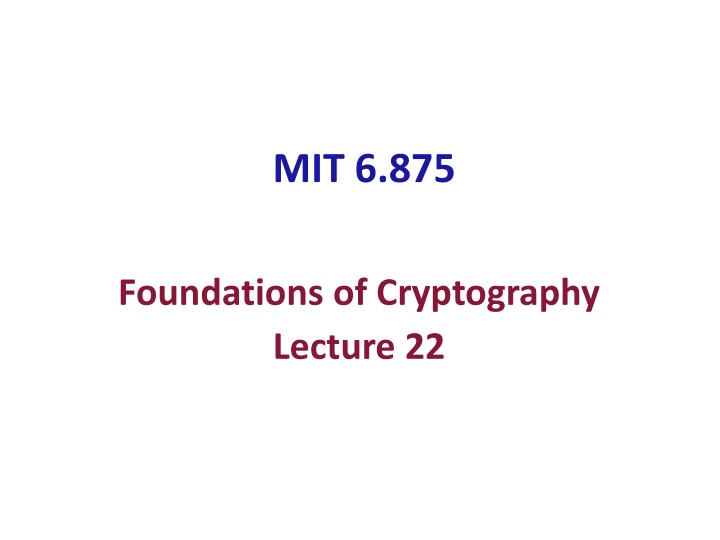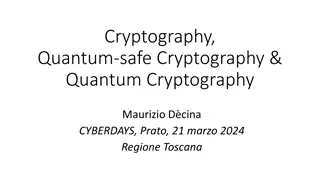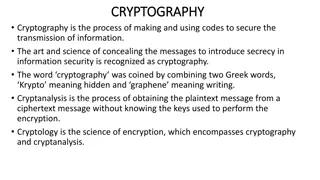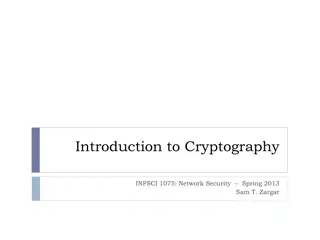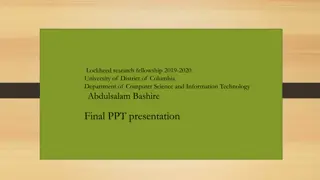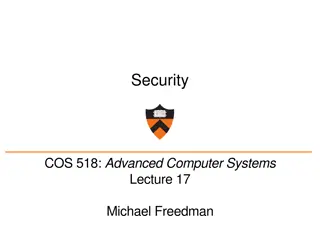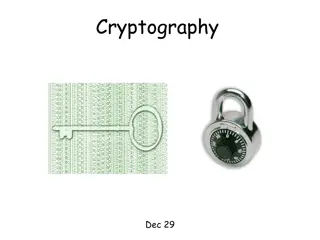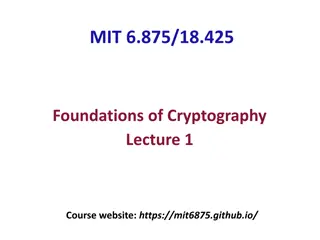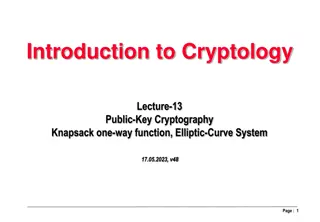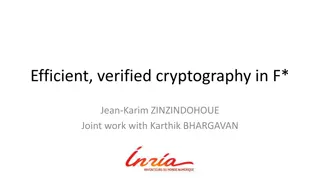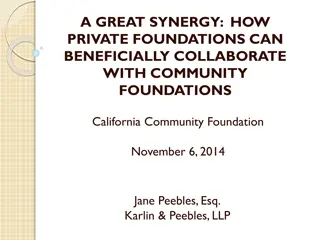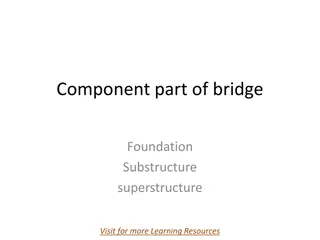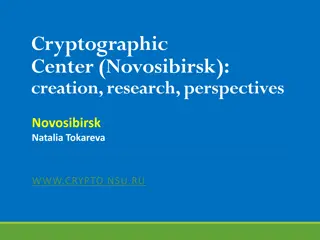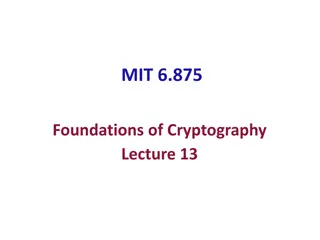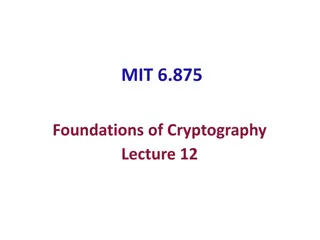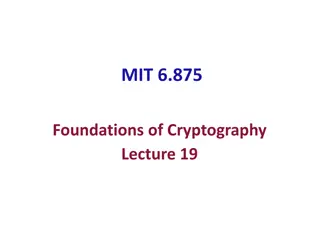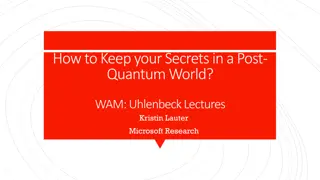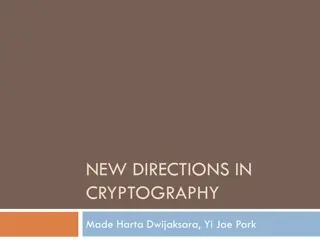MIT Foundations of Cryptography Lecture 22
In lecture 22 of MIT's Foundations of Cryptography series, delve into advanced cryptographic concepts and techniques. From modern encryption algorithms to cryptographic protocols, this lecture offers profound insights to enhance your cryptographic knowledge and understanding. Explore cutting-edge topics in the field of cryptography and broaden your understanding of secure communication systems. Dive deep into the mathematical foundations and principles that underpin the secure transmission of data in the digital age.
Download Presentation

Please find below an Image/Link to download the presentation.
The content on the website is provided AS IS for your information and personal use only. It may not be sold, licensed, or shared on other websites without obtaining consent from the author.If you encounter any issues during the download, it is possible that the publisher has removed the file from their server.
You are allowed to download the files provided on this website for personal or commercial use, subject to the condition that they are used lawfully. All files are the property of their respective owners.
The content on the website is provided AS IS for your information and personal use only. It may not be sold, licensed, or shared on other websites without obtaining consent from the author.
E N D
Presentation Transcript
MIT 6.875 Foundations of Cryptography Lecture 22
Complexity of the 2PC protocols Number of OT protocol invocations = 2 #??? gates Can be made into O(#inputs ?): Yao s garbled circuits Number of rounds = AND-depth of the circuit Can be made into O(1) rounds: Yao s garbled circuits Communication in bits = ?(#??? ? + #???????) Can be made into O(? #inputs) using FHE: but FHE is computationally more expensive concretely.
Application 1. Secure Outsourcing Input: x Program: P Enc(x) x Enc(P(x)) P(x) Client Server (the Cloud) A Special Case: Encrypted Database Lookup also called private information retrieval (we ll see in two lectures)
Application 2. Secure Collaboration Hospital ID Genome ID Phenotype Parties learn the genotype-phenotype correlations and nothing else
Homomorphic Encryption: Syntax (can be either secret-key or public-key enc) 4-tuple of PPT algorithms (???,???,???,????) s.t. ??,?? ??? 1?. PPT Key generation algorithm generates a secret key as well as a (public) evaluation key. ? ??? ??,? . Encryption algorithm uses the secret key to encrypt message ?. ? ???? ??,?,? . Homomorphic evaluation algorithm uses the evaluation key to produce an evaluated ciphertext ? . ? ??? ??,? . Decryption algorithm uses the secret key to decrypt ciphertext ?.
Homomorphic Encryption: Correctness ???(??,???? ??,?,???(?)) = ?(?). Plaintext world ?(?) ? ????? ????? ? ? ????? Ciphertext world
Homomorphic Encryption: Security Input: x Function: f Enc(sk,x) Enc(f(x)) ? Client Server (the Cloud) Security against the curious cloud = standard IND-security of secret-key encryption Key Point: Eval is an entirely public algorithm with public inputs.
Here is a homomorphic encryption scheme ??, ??? 1?. Use any old secret key enc scheme. ? ??? ??,? . Just the secret key encryption algorithm ? ???? ??,?,? . Output ? = ? || ?. So Eval is basically the identity function!! ? ??? ??,? . Parse ? = ?||? as a ciphertext concatenated with a function description. Decrypt ? and compute the function ?. This is correct and it is IND-secure.
Homomorphic Encryption: Compactness The size (bit-length) of the evaluated ciphertext and the runtime of the decryption is independent of the complexity of the evaluated function. A Relaxation: The size (bit-length) of the evaluated ciphertext and the runtime of the decryption depends sublinearly on the complexity of the evaluated function.
How to Compute Arbitrary Functions For us, programs = functions = Boolean circuits with XOR (+ ??? 2) and AND ( ??? 2) gates. ???((?1+ ?2)?3?4) X ???(?3?4) ???(?1+ ?2) X + ???(?3) ???(?4) ???(?1) ???(?2) Takeaway: If you can compute XOR and AND on encrypted bits, you can compute everything.
How to Compute Arbitrary Functions For us, programs = functions = Boolean circuits with XOR (+ ??? 2) and AND ( ??? 2) gates. ???((?1+ ?2)?3?4) X ???(?3?4) ???(?1+ ?2) X + ???(?3) ???(?4) ???(?1) ???(?2) We already know how to add (XOR), can we multiply?? Next lecture
Homomorphic Encryption: Syntax (can be either secret-key or public-key enc) 4-tuple of PPT algorithms (???,???,???,????) s.t. ??,?? ??? 1?. PPT Key generation algorithm generates a secret key as well as a (public) evaluation key. Encryption algorithm uses the secret key to encrypt message ?. ? ??? ??,? . Homomorphic evaluation algorithm uses the evaluation key to produce an evaluated ciphertext ? . ? ???? ??,?,? . Decryption algorithm uses the secret key to decrypt ciphertext ?. ? ??? ??,? .
Homomorphic Encryption: Correctness ???(??,???? ??,?,???(?)) = ?(?). Plaintext world ?(?) ? ????? ????? ? ? ????? Ciphertext world
Homomorphic Encryption: Security Input: x Function: f Enc(sk,x) Enc(f(x)) ? Client Server (the Cloud) Security against the curious cloud = standard IND- security of secret-key encryption Key Point: Eval is an entirely public algorithm with public inputs.
Here is a homomorphic encryption scheme ??, ??? 1?. Use any old secret key enc scheme. Just the secret key encryption algorithm ? ??? ??,? . Output ? = ? || ?. So Eval is basically the identity function!! ? ???? ??,?,? . Parse ? = ?||? as a ciphertext concatenated with a function description. Decrypt ? and compute the function ?. ? ??? ??,? . This is correct and it is IND-secure.
Homomorphic Encryption: Compactness The size (bit-length) of the evaluated ciphertext is independent of the complexity of the evaluated function. A Relaxation: The size (bit-length) of the evaluated ciphertext and the runtime of the decryption depends sublinearly on the complexity of the evaluated function.
Big Picture: Two Steps to FHE Leveled Secret-key Homomorphic Encryption: Evaluate circuits of a-priori bounded depth d you give me a depth bound d, I will give you a homomorphic scheme that handles depth-d circuits Bootstrapping Theorem: From circular secure Leveled FHE to Pure FHE (at the cost of an additional assumption) I will give you homomorphic scheme that handles circuits of ANY size/depth
How to Compute Arbitrary Functions For us, programs = functions = Boolean circuits with XOR (+ ??? 2) and AND ( ??? 2) gates. ???((?1+ ?2)?3?4) X ???(?3?4) ???(?1+ ?2) X + ???(?3) ???(?4) ???(?1) ???(?2) Takeaway: If you can compute XOR and AND on encrypted bits, you can compute everything.
How to Compute Arbitrary Functions For us, programs = functions = Boolean circuits with XOR (+ ??? 2) and AND ( ??? 2) gates. ???((?1+ ?2)?3?4) X ???(?3?4) ???(?1+ ?2) X + ???(?3) ???(?4) ???(?1) ???(?2) We already know how to add (XOR), can we multiply??
New (Secret-key) Encryption: Take 1 Private key: a vector s ?? ? Private-key Encryption of a bit ? {?,?}: ? ??+ ? ? C = (? is random (n) X (n+1) matrix) Decryption: [s || -1] C = m [s || -1] (mod q) Message = Eigenvalue Ciphertext matrix = Eigenvector Priv key INSECURE! Easy to solve linear equations.
New (Secret-key) Encryption: Take 1 t . C = m . t (mod q) t = [s || -1] Homomorphic addition: C1+ C2 t is an eigenvector of C1+C2 with eigenvalue m1+m2 Homomorphic multiplication: C1C2 t is an eigenvector of C1C2 with eigenvalue m1m2 Proof: t . C1 C2= =(m1. t) . C2= = m1. m2 . t But, remember, the scheme is insecure? Key idea: fix insecurity while retaining homomorphism.
New (Secret-key) Encryption: Take 2 Private key: a vector s ?? ? Private-key Encryption of a bit ? {?,?}: ? (? is random (n+1) X n matrix) C = ?? + ?+ ? ? Decryption: [s || -1] C m [s || -1] (mod q) Message = Approx Ciphertext matrix Priv key = Approx Eigenvector Eigenvalue CPA-secure by LWE.
New (Secret-key) Encryption: Take 2 t . C = m . t + e (mod q) t = [s || -1] Homomorphic addition: C1+ C2 = ??1+ ??2 ? (?1+ ?2) = ?1 ? + ?1+ ?2 ? + ?2 Noise grows a little = (?1+?2) ? + ( ?1+ ?2) (?1+?2) ?
New (Secret-key) Encryption: Take 2 t . C = m . t + e (mod q) t = [s || -1] Homomorphic multiplication: C1C2 Can also use ?2?1 ? (?1 ?2) = ?1 ? + ?1?2 = ?1 ??2+ ?1?2 = ?1?2 ? + ?2 + ?1?2 Noise grows. Need ?? to be small! How?! = ?1?2 ? + ?1 ?2+ ?1?2 ?????
Aside: Binary Decomposition Break each entry in ? into its binary representation 0 1 1 0 0 1 1 0 1 1 0 0 ? =3 5 4 (??? 8) ???? ? = (??? 8) 1 Small entries like we wanted! Consider the reverse operation: ? log? 4 2 1 0 0 0 0 0 0 4 2 1 ???? ? = ? ? ? = ? ? ? 1(?) ? Denote: ? 1?which has small entries ?
New (Secret-key) Encryption: Take 3 Private key: a vector s ?? ? Private-key Encryption of a bit ? {?,?}: ? (? is random (n+1) X n log q matrix) C = ?? + ?+ ? ? Decryption: [s || -1] C m [s || -1] G (mod q) Message = Approx Ciphertext matrix Priv key = Approx Eigenvector Eigenvalue Still CPA-secure by LWE.
New (Secret-key) Encryption: Take 3 t . C = m . t. G + e (mod q) t = [s || -1] ?????= ?1 ? 1(?2) Homomorphic multiplication: ? ?1 ? 1?2 = ( ?1+ ?1 ? ?) ? 1?2 = ?1 ? 1?2 + ?1 ? ? ? 1?2 = ?1 ? 1?2 + ?1 ? ?2 = ?1 ? 1?2 + ?1 ( ?2+ ?2 ? ?) = ?1 ? 1?2 + ?1 ?2 + ?1?2 ? ? ????? ????? ? log ? ?1 + ?1 ?2 ? log ? + 1 max{ ?1, ?2}
??? ? = ? log ? Homomorphic Circuit Evaluation Noise grows during homomorphic eval Depth ? ??????? ??????? ? + 1? ?0 ???0 Decryptable if ? ???0. (for security: ? 2?) So this can support ? ??.?? ??+1 (? + 1) ?? ?????? ?0 ??????
Big Picture: Two Steps to FHE Leveled Secret-key Homomorphic Encryption: Evaluate circuits of a-priori bounded depth d you give me a depth bound d, I will give you a homomorphic scheme that handles depth-d circuits Bootstrapping Theorem: From circular secure Leveled FHE to Pure FHE (at the cost of an additional assumption) I will give you homomorphic scheme that handles circuits of ANY size/depth
From Leveled to Fully Homomorphic Input: x Function: f Enc(sk,x) ? Client Server (the Cloud) The cloud keeps homomorphically computing, but after a certain depth, the ciphertext is too noisy to be useful. What to do? Idea: Bootstrapping !
Bootstrapping: How But the evaluator/cloud does not have SK! Best Possible Noise Reduction = Decryption! m Noiseless ciphertext ???( ,??) Very Noisy ciphertext SK Decryption Circuit
Bootstrapping, Concretely Next Best = Homomorphic Decryption! * Assume server knows ek =EncSK(SK). (OK assuming the scheme is circular secure ) EncSK(m) ???( ,??) EncSK(SK)
Bootstrapping, Concretely Next Best = Homomorphic Decryption! * Assume server knows ek =EncSK(SK). (OK assuming the scheme is circular secure ) Bdec Independent of Binput EncSK(m) Noise = Bdec Noise = Binput ???( ,??) EncSK(SK)
Wrap Up: Bootstrapping Function f Assume Circular Security: Evaluation key is EncSK(SK) g
Wrap Up: Bootstrapping Function f Assume Circular Security: Evaluation key is EncSK(SK) g Each Gate g Gadget G: g(a,b) g a b g(a,b) g ???( ,??) ???( ,??) a b sk sk
Wrap Up: Bootstrapping Function f Assume Circular Security: Evaluation key is EncSK(SK) g Each Gate g Gadget G: Enc(g(a,b)) g a b g(a,b) g ???( ,??) ???( ,??) a b Enc(sk) Enc(sk)
Subsequent Work: FHE in Practice ?? ?1 ?2 ?3 [Gentry-Halevi-Smart 12]: FHE with Polylog Overhead Homomorphic computations in place . ?? ?1 ?2 ?3 SIMD computation + slot permutations (automorphisms) HELib : The first homomorphic encryption library. SEAL PALISADE HEEAN FHEW TFHE Concrete NFLLib Lattigo cuFHE ? G del Prize Lecture 2022 Zvika Brakerski, Craig Gentry and Vinod Vaikuntanathan
FHE Bounty #1: We have leveled FHE from the LWE assumption ?????3(??2) ?????2(??1) ??????(??? 1) ?????4(??3) ??1 ??2 ??3 ??? and unbounded FHE under a circular secure LWE assumption. ?????(??) ?? G del Prize Lecture 2022 Zvika Brakerski, Craig Gentry and Vinod Vaikuntanathan
FHE Bounty #1: Why Circular Security? Partial Answer: [CLTV 15]: Unbounded FHE from indistinguishability obfuscation (IO). + [JLS 22]: Unbounded FHE from LPN + PRG in NC0 + Bilinear maps. (Unbounded) FHE from LWE. G del Prize Lecture 2022 Zvika Brakerski, Craig Gentry and Vinod Vaikuntanathan
FHE Bounty #2: Why Lattices/LWE? FHE from the Diffie-Hellman assumption. G del Prize Lecture 2022 Zvika Brakerski, Craig Gentry and Vinod Vaikuntanathan
FHE Bounty #3: FHE as efficient as plaintext computation. Advances in Rate-1 FHE: FHE with 0communication overhead [GH 19, BDGM 19] Advances in Private Information Retrieval: PIR with server computation 1 add + 1 mult per database byte* [CHHV 22] If you solve truly practical FHE, you don t need my $100(0). G del Prize Lecture 2022 Zvika Brakerski, Craig Gentry and Vinod Vaikuntanathan
Unresolved Issue 1: Function Privacy Input: x Function: f Enc(sk,x) Enc(sk, f(x)) ? Client Server (the Cloud) Security against the curious cloud = standard IND- security of secret-key encryption Security against a curious user?
Unresolved Issue 1: Function Privacy Input: x Function: f Enc(sk,x) Enc(f(x)) ? Client Server (the Cloud) Function Privacy: Enc(f(x)) reveals no more information (about f) than f(x). Function privacy via noise-flooding (on the board)
Unresolved Issue 2: Malicious Client Input: x Function: f Enc(sk,x) Enc(f(x)) ? Client Server (the Cloud) Idea: Use zero knowledge proofs.
Unresolved Issue 3: Malicious Cloud Input: x Function: f Enc(sk,x) Enc(f(x)) ? Client Server (the Cloud) Idea: Succinct Interactive Proofs . [Kilian92]
